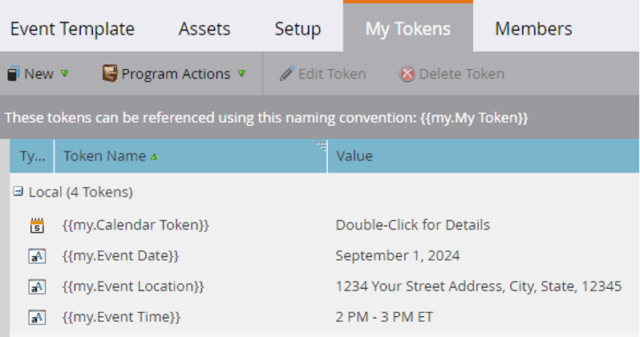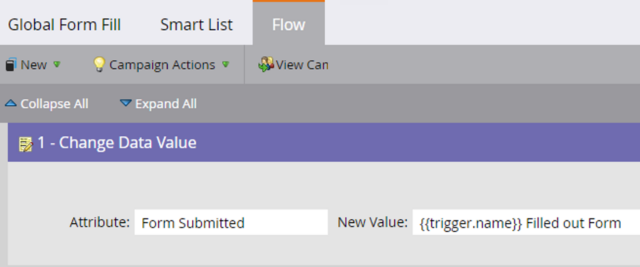Blog

Have you ever created an event campaign in Marketo, only to have the date of the event changed, after you created all the assets? This means having to go into every single asset and manually change the date to the new one. Not only does this take extra time, but it can also be super frustrating.
Thankfully Marketo has a great feature called tokens that can help you update program information in a snap. This article will help you understand what tokens are, how to use them, ideal use cases, and what to be on the lookout for when using them.
What are Marketo tokens?
Tokens are variables that can insert information into a Marketo asset. They can be used in campaign flow steps, emails, landing pages, snippets, and web campaigns. They populate information from a variety of sources including person records, campaigns, system triggers or programs. You can check out the extensive list of available Marketo tokens here.
When should I use them?
Marketo tokens are extremely versatile, and can be used in many situations, such as:
- Personalization. Inserting a person’s name, or company name
- Consistency. Inserting copyright year into all assets
- Efficiency. Updating an event location in a program
These are just a few examples of when tokens can be used. They’re undoubtedly a useful item in your Marketo toolbox.
Three examples of Marketo tokens.
Most people immediately think of email personalization when they first get started using tokens. The most common example is adding a person’s name into the salutation or the company name into the subject line. But there are so many other more advanced and powerful ways to use them. Here are three different examples of ways to use tokens.
Example 1: Updating copyright year.
Every January companies have to go into all their emails and landing pages and update the copyright year to the new date. Instead of spending hours doing this on each and every asset, companies could create a single token that does the same job.
Tokens can be inherited from folder structures or programs the asset is nested under. So, if you create a custom token titled “Copyright Year” in the highest folder possible, that token will be inherited by every program nested within that folder.
Think of it like this—you have a main folder titled “Marketing Campaigns”, then inside of that folder you create one folder for webinars, another for emails, another for events and so on. If you create a copyright year token in the “Marketing Campaign” folder all the other folders and programs underneath it will automatically inherit the token. Then you can use the one token on all emails and landing pages you create.
When you get to the end of the year, you can update one token and have every asset update automatically. This is a great way to save time and also ensure that your information stays up to date.
Example 2: Event program tokens.
Program tokens are great time savers and can help ensure consistency across assets. Event programs are a great use case for these tokens. For example, you can create a token for the time or the location of the event. When creating the emails and landing pages for your program, instead of writing “2 PM – 3 PM ET” as the event time, you will use the program token that you just created called {{my.Event Time}}. This can be used in all the places you would have written in “2 PM – 3 PM ET”.
Then if the timing of the event were to change, instead of having to manually go into every email and landing page that lists the time, you just change the information in the program token and it will update everywhere the token is used. This can save you a great amount of time on repeatable tasks.
Think about this on a larger scale. Let’s say your company hosts the same pre-recorded webinar every month. All the information about the webinar is the same, but the date and time are updated every month. If you templatize this webinar and create tokens for the date and time, you would only need to update those tokens each month.
This approach eliminates the need to manually update the date and time across all assets, including invites, thank-you notes, reminders, and landing pages. This could save you hours every month and free you up to do other things.

Example 3: Populating information in fields.
Another even more advanced use case for Marketo tokens is populating information in fields. Let’s say your company keeps track of the most recent form every person has filled out.
Instead of adding a flow step to every form fill program to populate information into the field, you can create a single global operational program. This program can use the {{trigger.Name}} token to populate the information within the flow step. This way you don’t have to worry that a marketer may forget to add that step into a new program. You can feel confident that your global program will catch all form fills and populate that information every time.


Avoid these Marketo token mistakes.
While tokens can be extremely useful, here are a couple key areas where you should be particularly careful.
Names for email personalization.
The classic is when populating information in an email with information found in a person’s record. How many times have you stumbled across a record that has a first name filled in as “UNKNOWN”, or “Called Bill not William”? No one wants to send out (or receive) an email saying, “Dear He isn’t nice to speak with…” So be sure that anyone entering data into your system knows that it might be used to populate emails and that it should be populated correctly.
Default values.
Always make sure you add in a default value for your tokens. If the field you’re referencing is empty for someone, the default value will automatically be used instead—if you’ve set it up. This way your sentence will read “did you know your company can save” and not “did you know can save.” By filling in a default value of “your company”, you saved the readability—and effectiveness—of your email.
Check out your fields ahead of time.
To check what information is written in a field, you can run a Lead Performance report in Marketo. In the Setup tab, group the report by the information you will be using, such as “first name” or “company name.”
Of course this report will be very large. But it will give you a good feeling for what sort of information is in the field you want to use. Is the field mostly blank? Are there lots of names in all capital letters? Does it have wording in there that is not useful? Either way this type of report will give you a good feel for the information in the field.
The Iron Horse insight.
Tokens can significantly streamline your Marketo processes and enhance personalization. By using tokens wisely, you can save time and ensure consistency across your marketing assets. If you use Marketo, we highly recommend incorporating tokens into your processes.

See what else you might be missing out on with Marketo. Read more
Subscribe to our blog.
Get unstuck with the most interesting business ideas and our insights delivered to your inbox.